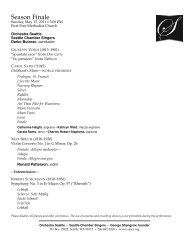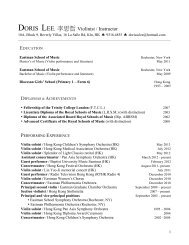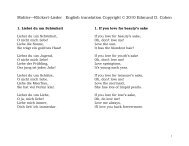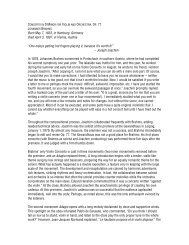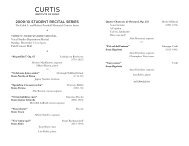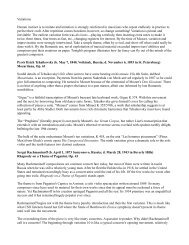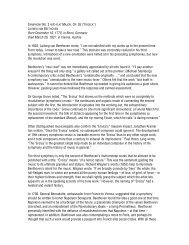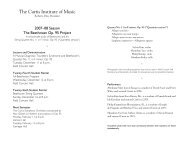PROGRAM NOTES: Marin Marais (1656-1728 ... - InstantEncore
PROGRAM NOTES: Marin Marais (1656-1728 ... - InstantEncore
PROGRAM NOTES: Marin Marais (1656-1728 ... - InstantEncore
You also want an ePaper? Increase the reach of your titles
YUMPU automatically turns print PDFs into web optimized ePapers that Google loves.
<strong>PROGRAM</strong> <strong>NOTES</strong>:<br />
<strong>Marin</strong> <strong>Marais</strong> (<strong>1656</strong>-<strong>1728</strong>) established himself as a virtuoso of the viola da gamba<br />
at a young age, earning the opportunity to study gamba with Monsieur de Saint<br />
Colombe and composition with Jean-‐Baptiste Lully. <strong>Marais</strong> became one of the most<br />
prolific composers of bass viola da gamba repertoire.<br />
<strong>Marais</strong> approached composition differently than his predecessors. Rather than<br />
leaving ornamentation to the discretion of the performer, <strong>Marais</strong> created his own<br />
system of symbols depicting specific graces. His desire to have complete control<br />
over every gesture stemmed from his studies with Lully, a composer who was also<br />
notorious for adding precise ornamentation instructions.<br />
La Gamme en forme d’un petit Opera (1723) is one of several trio sonatas <strong>Marais</strong><br />
composed for violin, viola da gamba, and harpsichord. Each instrumental part in<br />
this piece is equally challenging, creating a contrast of virtuosic lines throughout<br />
each voice. The title “a scale in the form of a petit opera” suggests that <strong>Marais</strong>’ goal<br />
through this composition was to depict the same drama and variation as a short<br />
opera. Beginning in the key of C Major, <strong>Marais</strong> travels through each step of the scale<br />
to create these various operatic scenes. Unlike <strong>Marais</strong>’ earlier works, this piece has<br />
very few instructions on where to ornament. Therefore, the biggest challenge as a<br />
performer is finding ways to embellish nuances in order to depict the vast amounts<br />
of character changes that take place in this enormous work. Because the piece was<br />
composed in the last year of his life, <strong>Marais</strong> probable assumed anyone performing it<br />
would have studied his earlier music and would therefore understand the style of<br />
ornamentation he demands.<br />
<strong>Marais</strong> is most known for his collection of suites for viola da gamba, which are<br />
divided into 5 books of over 550 songs. Similar to the standard baroque suite,<br />
<strong>Marais</strong>’ suites include dance movements. However, rather than having a set number<br />
of movements per suite, <strong>Marais</strong> created books of suites that relate to a “choose-‐<br />
your-‐own-‐adventure” novel. The irony lies in the fact that <strong>Marais</strong> was determined<br />
to control how evey ornament and gesture was placed in his music, yet left the<br />
overall structure of the performance entirely up to the performer.<br />
Suite in E minor from Pieces de Violes Book II exemplifies the complex detail with<br />
which <strong>Marais</strong> composed. The movements performed today are a small selection of<br />
the large work. All of <strong>Marais</strong> suites begin the same way, with a single Prelude. This<br />
slow beginning introduces the overall character of the suite. This expressive and<br />
slow movement is intended to introduce the overall character of the suite. The<br />
irregular phrase length and improvisatory gestures bear out typical French prelude<br />
characteristics, portraying the affect of this somber E minor suite. The light and airy<br />
Fantasie follows, gently segueing into standard dance suite movements: Allemande,<br />
Courante, Sarabande, and Menuet.
The conclusion of the sections I am playing today represents something<br />
unique to <strong>Marais</strong>. In his suites he generally incorporates character pieces into the<br />
setting, which ties much of the work together. In this suite, <strong>Marais</strong> wrote a Tombeau<br />
(a work commemorating the death of someone) to his teacher Monsieur de Saint<br />
Colombe. <strong>Marais</strong> meticulously planned and crated each gesture to represent the<br />
loss of his beloved teacher. From the sound of someone’s final heartbeat, to the<br />
weeping of someone mourning, <strong>Marais</strong> captures the essence of our emotions<br />
through this work.




